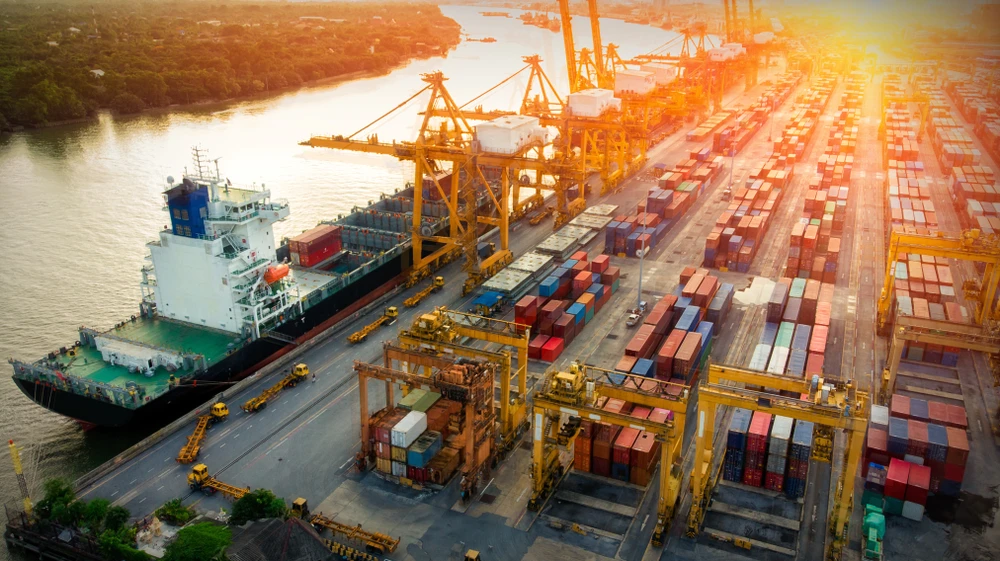
Cumulatively, Vietnam’s economy expanded 6.42% y/y in the first half of 2024, well ahead of 3.84% in 1H23. The robust outcome sets a positive tone for the rest of this year after a challenging 2023.
Both manufacturing and services sectors continue to provide support to much of the business activities, while external trade has maintained its strong pace in 2Q24. The upswing in semiconductor sales since mid-2023 suggests that momentum is likely to continue further in the 1-2 quarters ahead.
Outlook
With 2Q24 performance above our and market expectations and setting a positive tone, outlook for 2024 remains bright. However, we caution that second half of this year is likely to see a more muted performance, due to the higher base in 2H23 as well as downside risks that are still present. These include conflicts between Russia and Ukraine and in the Middle East which could disrupt global trade and energy markets. Nonetheless, the recovery in the semiconductor cycle, stable growth in China and the region, and the likely easing of monetary policy by major central banks will be supportive of outlook. We reaffirm our growth forecast for Vietnam at 6.0% for 2024, while the official growth target is at 6.0-6.5%.
Growth momentum extended into 2Q24
Data released by the General Statistics Office (GSO) on 29 Jun 2024 showed Vietnam’s real GDP expanded 6.93% y/y in 2Q24, extending the momentum from the upwardly revised 5.87% y/y pace in 1Q24 and 6.72% y/y gain in 4Q23, and beating the 4.05% gain in the same quarter in 2023. The outcome surprised on the upside, given our and market expectations of 6.0%, as both manufacturing and services sectors performed strongly in the quarter.
Cumulatively, Vietnam’s economy expanded 6.42% y/y in the first half of 2024, well ahead of 3.84% in 1H23. The robust outcome sets a positive tone for the rest of this year after a difficult and challenging 2023.
2Q24 growth was underpinned by contributions from the manufacturing sector which continued its fifth straight quarter of expansion, at 10.0% y/y (1Q24: 7.2%) and services sector which rose by 7.1% y/y (1Q24: 6.2%), its 11th consecutive quarter of gains since recovering from the slump during COVID-19 in 3Q21. These two sectors accounted for about 31% and 44% share, respectively, of the headline 6.93% growth in 2Q24. In the first half of 2024, manufacturing provided 29% share and service sector 45% of the 6.42% headline growth, compared to 28% and 49%, respectively in 1Q24.
Data from GSO showed that total retail trade recorded steady expansion through the first half of 2024, at 8.6% y/y YTD to Jun, compared to 8.1% at the start of 2024. Retail sales gained 7.37% y/y YTD to Jun while both travel services and hotel and catering sales recorded double digit gains as the tourism sector experienced ongoing recovery in tourist inflows. International arrivals to Vietnam hit 8.8 mn in Jun YTD, compared to 5.6 mn in the same period last year, with arrivals from South Korea (2.28 mn; 42% y/y increase) and China (1.89 mn; 3x increase from 0.6 mn in 1H23) accounting for nearly 50% of arrivals during the period.

Nonetheless, revival of domestic spending has put upward pressures on consumer prices, which saw Vietnam’s headline CPI accelerating for the 5th consecutive quarter, to 4.39% y/y in 2Q24 (3.77% in 1Q24), closing in on the central bank’s upper band of 4.50%. Contrary to the headline inflation, core CPI (ex-food, energy and goods managed by state agencies such as education and medical services) decelerated for the 5th quarter to 2.69% y/y (from 2.81% in 1Q24). GSO attributed to food and housing cost increases as the main contributors to headline inflation,
particularly due to rising costs of pork (due to African swine fever in late 2023), electricity as well as healthcare and education services.
Going forward, a factor that could impact on inflation is the planned 6% increase in minimum wage from Jul 2024, a slightly larger increase compared to 5.88% in Jul 2022. Vietnam had increased the minimum wage by 7.3%, 6.5%, and 5.3% in 2017, 2018, and 2019, respectively.
External demand remains encouraging
External trade performed strongly in 2Q24, boosted by consumer demand as well as recovery in the semiconductor cycle since mid-2023.
Despite the ongoing Russia-Ukraine conflict and dark clouds of shipping disruptions in the Red Sea, exports recorded its fourth month of double-digit increase, at 10.5% y/y in Jun (13.9% in May) while imports rose 13.1% y/y (25.7% in May). In the first half of 2024, exports and imports increased by 14.0% y/y and 16.6% y/y, respectively, for a trade surplus of USD11.3 bn (full year 2024: USD28.4 bn), which nearly matches the USD12.1 bn surplus achieved in the full year of 2022. This level of external surplus should help to instill confidence on Vietnam’s currency amidst the current strong US dollar environment. Much of the trade surplus is attributed to trade with the US while China is the largest source of Vietnam’s trade deficit.
In terms of exports products, computers, mobile phones, communications equipment, machinery, textile and garments, and footwear totaled about USD110 bn in the first half of 2024, or close to 60% of total exports of USD189 bn during the period. Vietnam’s main imports electronics parts, machinery, equipment, fabrics, steel, plastic came to USD89.7 bn, or about 50% of total imports of USD177.9 bn in first half of 2024.
Foreign investors are largely positive towards Vietnam’s prospects in the coming years, brushing past the bouts of domestic political uncertainty that dominated headlines in most of early 2024. Registered foreign direct investment (FDI) jumped 13.1% y/y to USD15.2 bn in Jun YTD, following the 13.4% gain in 1Q24. Singapore was the largest source of inflow at USD5.6 bn, well ahead of Japan (USD1.7 bn) and Hong Kong SAR (USD1.7 bn) and South Korea (USD1.4 bn). Manufacturing and processing sector accounted for the bulk of the investments in 2Q24 at 70.4% share compared to 63% share in 2Q23, followed by real estate (16.3%) and wholesale & retail (4%).
Realized (or disbursed) FDI inflows into the country came to USD10.8 bn in Jun YTD, more than doubled the USD 4.6 bn inflow in 1Q24. Note that realized FDI inflows into the country achieved a record high of USD 23.2 bn in 2023, surpassing the previous record of USD 22.4 bn in 2022. Meanwhile, registered FDI inflows in 2023 surged 32% to USD 36.6 bn from USD 27.7 bn in 2022, nearly matching the record high of USD 38 bn in 2019.
These FDI data suggest that: i) businesses have looked past the political uncertainty in early 2024 and continued to view Vietnam as an important investment destination in the mid to long term, amid the ongoing reconfiguration of global supply chains; ii) the increase in both realized and registered FDI inflows will further boost domestic activities in the quarters ahead including construction and employment; and iii) an affirmation of foreign enterprises’ confidence and commitment to the country in the current wave of de-globalisation, de-risking, and supply chains shifts.
Outlook – Prospects remain positive with caution ahead
With 2Q24 performance above our and market expectations and setting a positive tone, outlook for 2024 remains bright. However, we caution that second half of 2024 is likely to see a more muted performance, weighed by the higher base in 2H23 as well as downside risks that are still present. These include conflicts between Russia and Ukraine and in the Middle East between Israel and Hamas which could disrupt global trade and energy markets.
Nonetheless, the recovery in the semiconductor cycle, stable growth in China and the region, and the likely easing of monetary policy by major central banks will be supportive of outlook. We reaffirm our growth forecast for Vietnam at 6.0% for 2024, while the official growth target is at 6.0-6.5%.
Despite the recent development in the political arena, Vietnam’s long-standing policy of welcoming investors and businesses is expected to remain in place.
SBV to hold rates steady for now
The recent weakness of VND in the face of strong USD and the acceleration of inflation rates could see the State Bank of Vietnam (SBV) proceeding cautiously in any changes to its policy rates. Keeping in mind that that growth momentum is likely to be less stellar in the 2H24, we believe SBV will maintain its refinancing rate at current level of 4.50% for now.
With the European Central Bank taking a step forward by lowering interest rates in Jun, and the US Federal Reserve may start to ease its policy stance in the second half the year, this may open up opportunity for SBV to follow suit. For now, instead of further lowering interest rates, the government is continuing its focus on non-interest rate measures to support the economy.




















